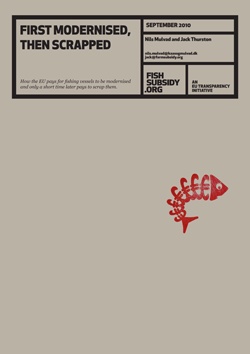Take a look at: FISHSUBSIDY.ORG and watch the cute video of seagulls discussing the EU CFP. This site is full of interesting information BUT:
Detailed information on subsidies since 2007 is no longer available in the public domain from either Brussels or National Administrations. So details on PUBLIC funds used to exploit PUBLIC resources are now kept under wraps. Similar to the Marine Fisheries Agency (MFA) website (the MFA preceded the Marine Management Organisation) where for a period, ALL details of court cases and prosecutions for fisheries offences were available in the public domain. Then the commercial lobby bleated that such information cast aspersions on the commercial catching sector AND for political expediency the data was removed.
Meanwhile, the RSA sector pay taxes that are used to prop up and support the destruction of public fishery resources that are crucial for the RSA sector’s survival.
A sample of the information available:
Sept. 12, 2010.
Overcapacity in the EU fishing fleet is one of the main factors contributing to overfishing. According to the European Commission the current EU fleet is two to three times the size required to catch the available fish stocks. In short, our ability to catch fish far exceeds the number of fish available.
In 2004 the EU stopped subsidising vessel construction but public money (EU funds and national co-financing) is still used for the modernisation of fishing vessels, without any assessment of how much this is contributing to over-fishing.
Analysis of fisheries subsidies data has revealed those vessels that received subsidies for modernisation only a short time later to receive subsidies for scrapping as an attempt to reduce the capacity of the fleet.
Between 1994 and 2006 shows that a total of 860 vessels received public aid for modernisation – sometimes several times – and subsequently for scrapping or in some cases transfer to third countries or reassignments to other uses. About half of the vessels are from Spain (326) and France (120). In some cases a very short time elapsed between the modernisation and scrapping. 32 vessels received subsidies for modernisation and less than a year later got subsidies for scrapping, reassignment or transfer to third countries.
In the case of the Spanish vessel Mikel Deuna Primero only 17 days passed between funding decisions for modernisation and scrapping. The Italian Mamma Assunta received more than €20,000 for modernisation in 2001 about two years later €70,000 for scrapping.
Taken together, the EU spent at least €15 million in subsidies for modernisation of vessels. It subsequently spent more than €150 million on scrapping the very same vessels. View the full list of modernised-then-scrapped vessels HERE.
These revelations were based on analysis of EU fisheries subsidy payments between 1994 and 2006. Spending public money on scrapping vessels that have previously received modernisation and construction subsidies is almost certain to be continuing today, however the data released by governments is less detailed than it used to be and so it is not possible to confirm this is the case. National governments continue to use the European Fisheries Fund to modernize vessels without even asking which stocks they will target.
With the large majority of stocks in bad shape and the consensus that fleet capacity has to be reduced it is likely that vessels receiving modernisation subsidies today will before very long be getting aid for scrapping. For example, the bluefin tuna fleet, built with the aid of EU subsidies, is likely soon to receive public aid to permanently or temporarily stop fishing because stocks are so depleted.
